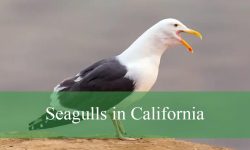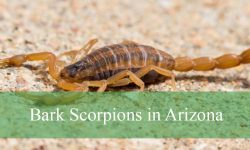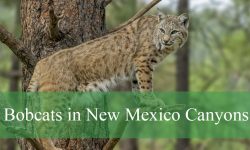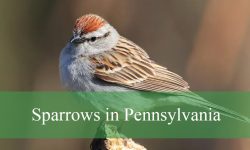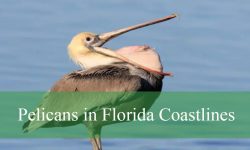Due to the contrast in their plumage, black birds with white stripes on their wings catch people’s attention. Whether flying across the skies or perched on trees, these bird species, with their striking wing patterns, contrast strikingly with different types of environments.
They are a sought-after sight for birdwatchers, providing a visual delight and arousing curiosity about their distinct traits and habits.
Different Types of Black Birds with White Stripes on Wings
Northern Mockingbird

The Northern Mockingbird, known scientifically as Mimus polyglottos, stands out with its grayish-black plumage and distinctive white wing stripes. Renowned for its exceptional singing abilities, it extends beyond its namesake North, reaching as far as Mexico, Central America, and even Hawaii.
These adept mimics imitate the songs of other birds and human-made sounds, displaying remarkable adaptability. Males fiercely defend nesting territories, while their omnivorous diet includes insects, fruits, and seeds.
The Northern Mockingbird typically measures between 8.2 and 10.2 inches (20.8–25.9 cm) in length, weighs approximately 1.4–2.0 ounces (40–58 g), and boasts a wingspan spanning 12–13 inches (30.5–33 cm). With a lifespan of up to 20 years.
Swallow-tailed Kite
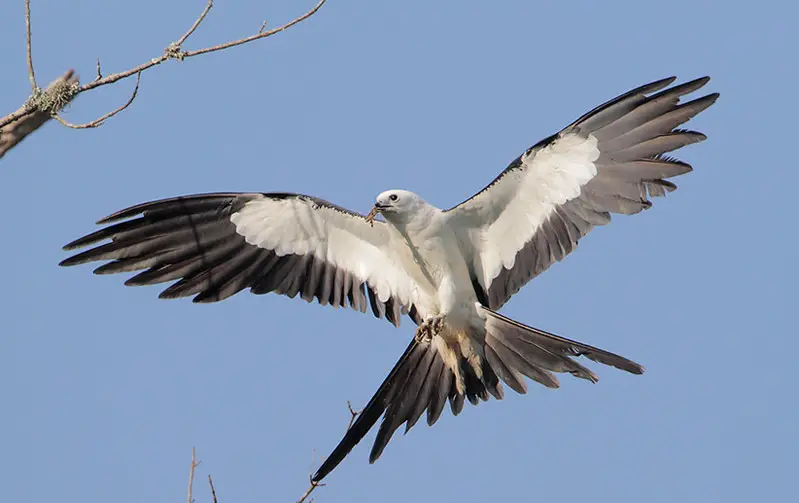
The Swallow-tailed Kite, known scientifically as Elanoides forficatus, mesmerizes with its distinctive long, deeply forked tail and striking black and white plumage. These magnificent birds of prey are found in the southeastern United States, as well as parts of Central and South America, where they prey on insects, reptiles, and small mammals.
In flight, they display unparalleled grace, effortlessly soaring high with spread wings and fluttering tails, earning them the title “the coolest bird in the sky.”
The Swallow-tailed Kite typically measures between 19 and 24 inches (48–61 cm) in length, weighs approximately 10–20 ounces (280–570 g), and boasts a wingspan spanning 54–60 inches (137–152 cm). With a lifespan of up to 15 years.
White-winged Scoter
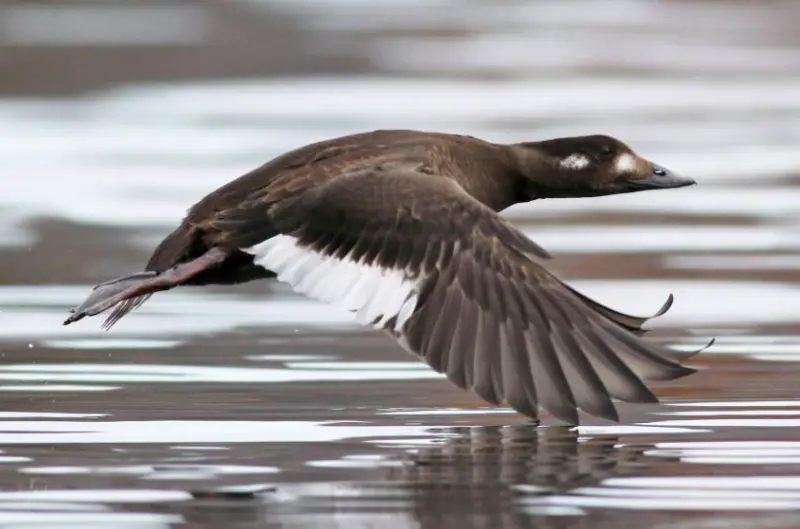
The majestic White-winged Scoter (Melanitta deglandi), a resident of the Northern Hemisphere, is easily recognized by its characteristic white wing patches when it is in flight. Its black plumage with white wing stripes identifies it as a particular kind of scoter. It descends to depths of up to 100 feet and feeds mostly on crustaceans and mollusks.
With a strong wingspan of up to 3.5 feet, this duck can fly at speeds of up to 60 miles per hour. Impressively, it is also a superb diver.
Eurasian Magpie
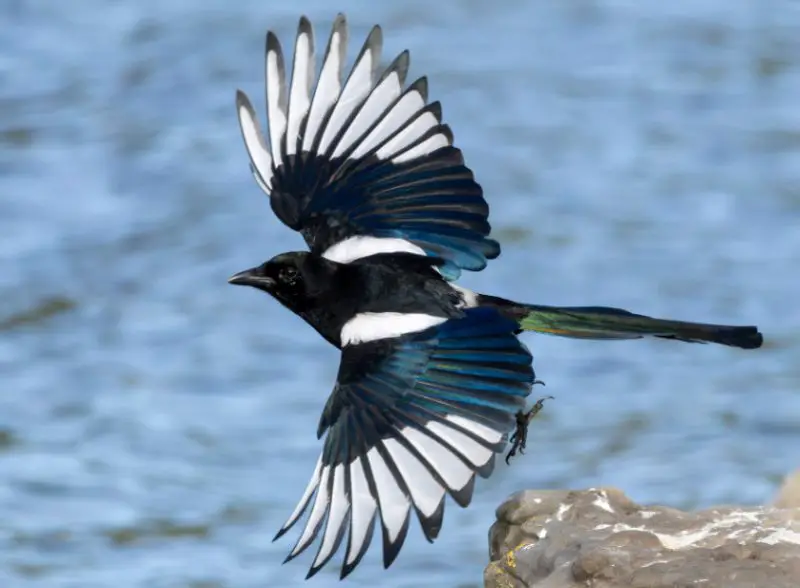
The Eurasian Magpie (Pica pica) typically measures between 17 and 21 inches (44–54 cm) in length, weighing approximately 7–8 ounces (200–230 g), with a wingspan spanning 22–26 inches (55–65 cm). With a lifespan of up to 21 years, these striking birds, thrive across Europe and parts of Asia.
It’s recognized for its glossy black head, wings, and tail, contrasting with a white belly and shoulder patches. Its striking black and white plumage, especially the white patches on its wings, makes it easily identifiable in flight.
These omnivorous birds consume insects, small mammals, fruits, and carrion. Living in large social groups called “parliaments,” they exhibit intricate social behaviors, including cooperative breeding and vocal communication.
American Oystercatcher
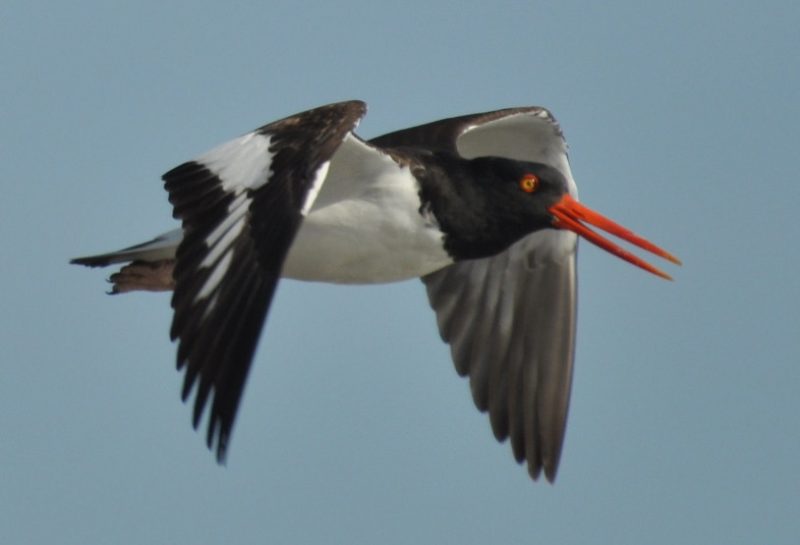
Popular coastal birds found in North America’s Atlantic and Gulf regions are the American Oystercatcher (Haematopus palliatus). They are distinct due to their eye-catching black and white feathers and their big, thick orange beak.
With their skill at cracking apart shells to get at the food, these birds are specialized feeders that especially enjoy oysters and other shellfish. As a means of communication for establishing territories and luring mates, their characteristic sounds reverberate throughout coastal environments.
The American Oystercatcher typically measures between 17 and 21 inches (43–53 cm) in length, weighing approximately 22.4–33.6 ounces (650–950 g), with a wingspan spanning 35–45 inches (89–114 cm). With a lifespan of up to 35 years.
California Condor
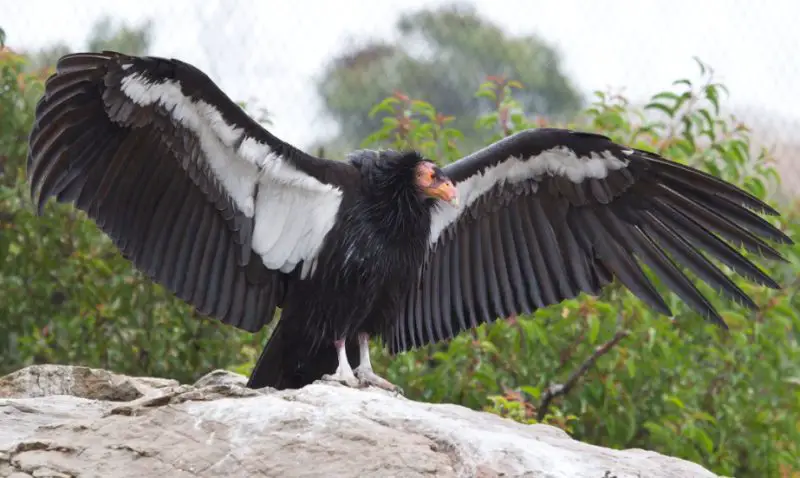
The California Condor (Gymnogyps californianus) is a colossal bird of North America, boasting a wingspan of up to 10 feet and weighing up to 25 pounds. Despite their imposing size, they are gentle carrion feeders, often observed soaring high in the sky using their keen eyesight.
Distinguished by black feathers and white patches on their wings’ undersides, they’re also recognized by their red heads. Once nearly extinct, their population has rebounded to around 500 individuals, thanks to intensive conservation efforts.
Turkey Vulture
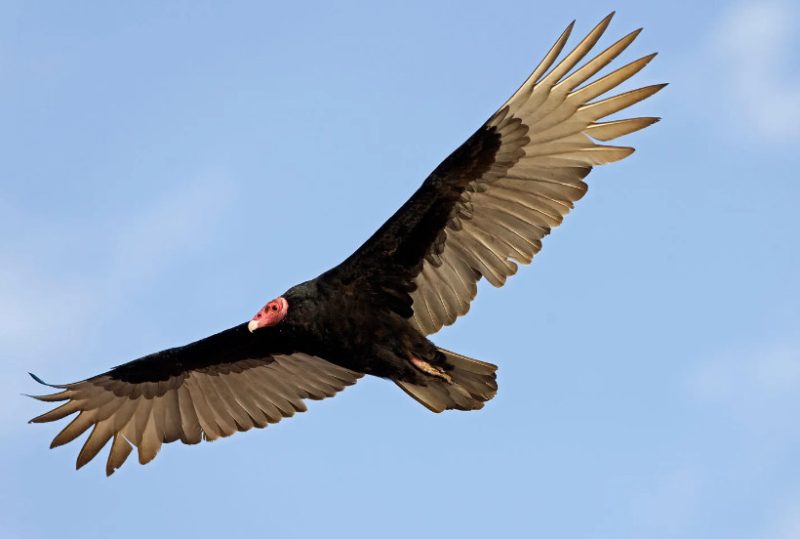
The Turkey Vulture (Cathartes aura), also called a buzzard or carrion crow, is a black bird with white wing stripes found across North and South America. As scavengers, they primarily feed on carrion, utilizing their keen sense of smell to detect decaying flesh from afar.
Despite their less-than-glamorous reputation, they play a crucial role in ecosystem health by cleaning up carcasses, thus preventing disease spread. Interestingly, Turkey Vultures employ vomiting as a defense mechanism when threatened—a unique adaptation in the avian world.
The Turkey Vulture typically measures between 25 and 32 inches (63–81 cm) in length, weighs approximately 68–72 ounces (1900–2040 g), and boasts a wingspan spanning 66–78 inches (168–198 cm). With a lifespan of up to 20 years.
Golden Eagle
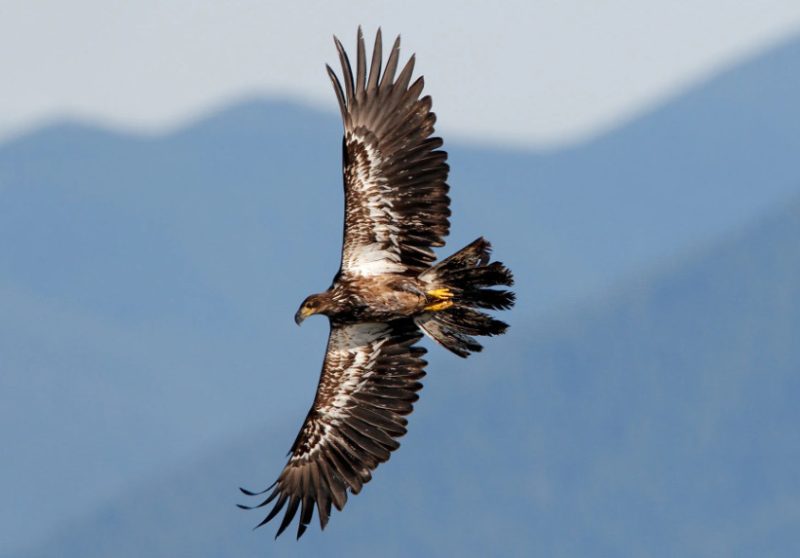
The Golden Eagle (Aquila chrysaetos) is a majestic bird of prey, widely distributed across North America, Europe, and Asia. With a wingspan of 59–83 inches (150–210 cm) and weighing 105.6–246.4 ounces (2980–6970 g), they are formidable hunters, symbolizing strength and freedom.
Sporting dark brown plumage with a golden head and neck, they exhibit a distinctive white patch at the base of their wings. Despite being of least concern to the IUCN, they face threats from habitat loss and human activities.
Black-crested Titmouse
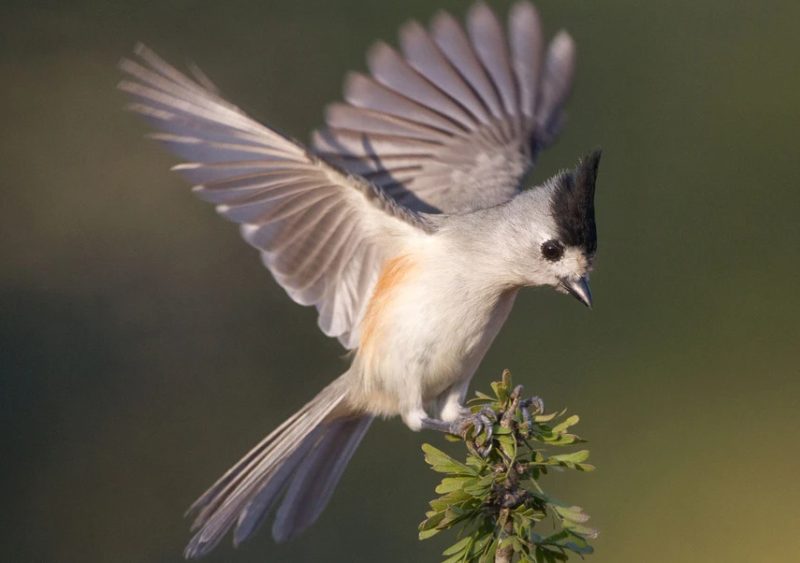
The Black-crested Titmouse measures approximately 5.5–6 inches (14–15 cm) in length, weighing around 0.3–0.4 ounces (9–12 g), with a wingspan of 8–9 inches (20–23 cm). With a potential lifespan of up to 17 years, these small birds, identified by their jet-black feathers, white cheeks, and striking white wing stripes, are native to the southern United States, particularly from Texas to Florida, thriving in woodlands and savannas.
Despite their diminutive size, they’re known for their vocal nature, filling woodlands and savannas with sharp, high-pitched calls and songs.
As agile fliers, they effortlessly navigate trees in search of insects, seeds, and berries. During breeding, males sport a prominent black crest, distinguishing them from females, who share the same striking black-and-white coloring.
White-winged Widowbird
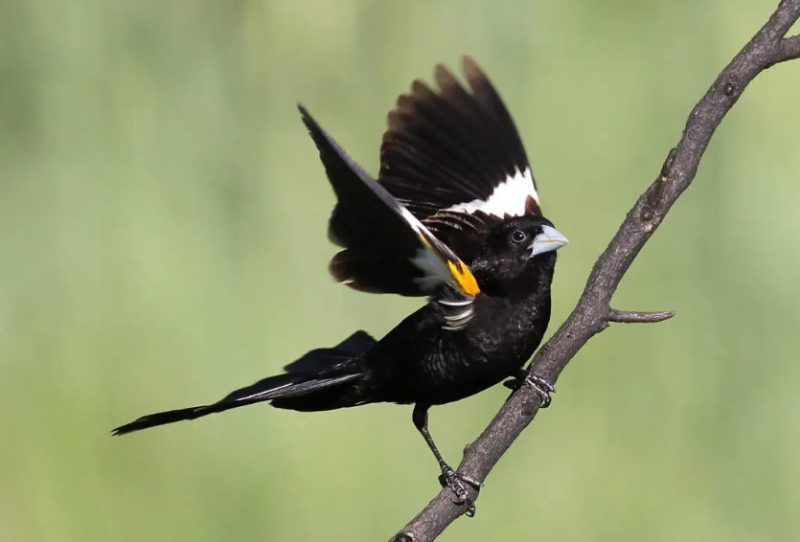
The White-winged Widowbird measures between 5.9 and 7.5 inches (15–19 cm) in length, weighing approximately 0.5–1.4 ounces (15–40 g), with a wingspan spanning 11–12 inches (28–30 cm). With a potential lifespan of up to 10 years, these striking birds, distinguished by their long white wing feathers and black plumage, are native to Africa, thriving in various habitats like grasslands, savannas, and wetlands.
Male birds perform intricate songs and wing-flapping rituals to attract mates and assert dominance. Besides, they contribute to ecosystem balance by primarily feeding on seeds, aiding in weed control, and also serving as prey for larger predators like raptors and snakes.
Common Black Hawk
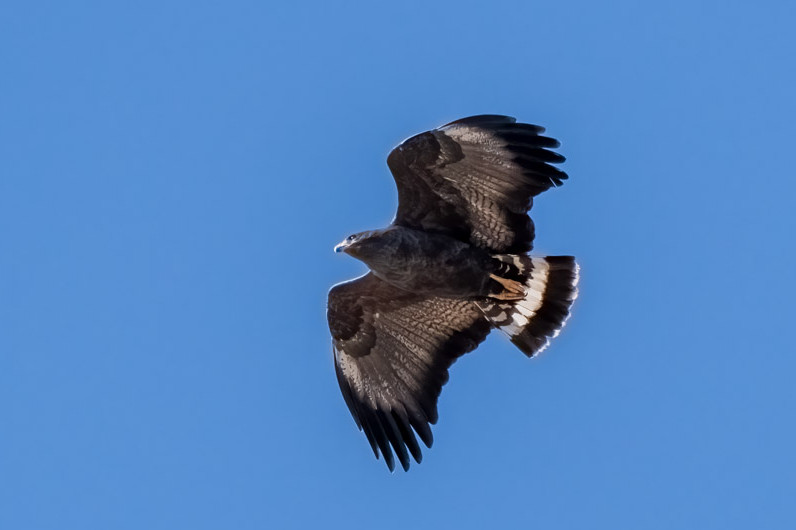
The Common Black Hawk (Buteogallus anthracinus) measures between 19 and 24 inches (48–61 cm) in length, weighing approximately 24–50 ounces (680–1415 g), with a wingspan ranging from 43 to 55 inches (110–140 cm).
With a potential lifespan of up to 25 years, these impressive raptors, identified by their predominantly black plumage and white wing stripes, are widespread across America. They are renowned for their agility and hunting prowess, making them formidable predators in their habitats.
Blackpoll Warbler

The Common Black Hawk (Buteogallus anthracinus), a raptor widespread across America, stands out with its predominantly black plumage and distinctive white wing stripes. Belonging to the group of birds with yellow beaks, it possesses a wingspan of up to four feet, enabling impressive hunting prowess.
Renowned for their stealth and agility, they adeptly swoop down from heights to catch prey. Revered in some cultures as symbols of power, their striking appearance and hunting skills inspire legends and stories.
The Blackpoll Warbler measures between 4.9 and 5.9 inches (12.5–15 cm) in length, weighing approximately 0.3–0.4 ounces (9–12 g), with a wingspan ranging from 7.9 to 9.8 inches (20–25 cm). With a potential lifespan of up to 11 years.
Tufted Duck

The Tufted Duck, also known as the Tufted Pochard, typically measures between 16 and 20 inches (40–50 cm) in length, weighs around 19.2–38.4 ounces (550–1100 g), and boasts a wingspan spanning 28–33 inches (71–84 cm). With a lifespan of up to 15 years, this diving duck species inhabits various wetland habitats across northern Eurasia, utilizing its skills in diving to feed on mollusks and aquatic insects.
It has a white side and is distinguished by its glossy black head, back, and characteristic tuft of feathers. Males have a vivid blue beak and eyes, with a white patch on their side, and a brownish head while breeding.
Oriental Magpie-Robin
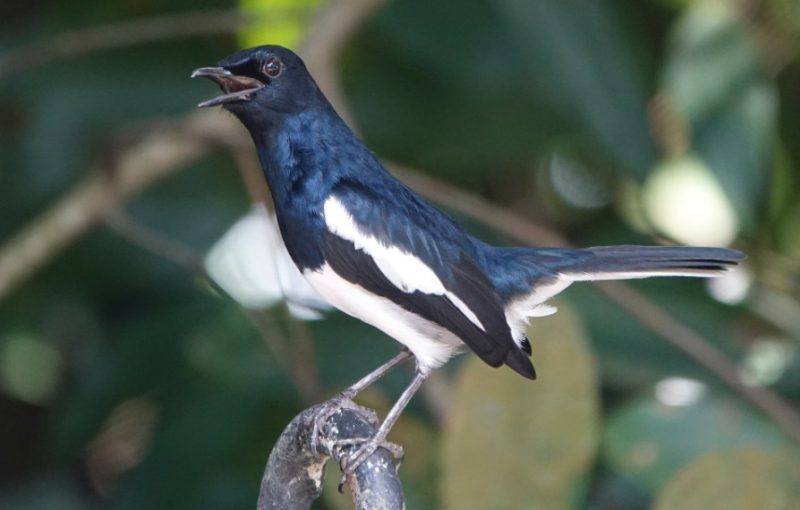
The Oriental Magpie-Robin (Copsychus saularis) is a striking bird, predominantly black with contrasting white markings, native to India and Southeast Asia. Belonging to the Old World flycatchers, these birds inhabit various environments, from forests to urban areas.
Omnivorous in nature, they feed on insects, fruits, and small animals. Often territorial, they fiercely protect their nests and feeding grounds. In some traditions, they are seen as symbols of fortune and are cherished as pets.
The Oriental Magpie-Robin measures between 6.3 and 7.1 inches (16–18 cm) in length, weighing approximately 1.1–1.6 ounces (32–45 g). With a wingspan ranging from 10.2 to 11.4 inches (26–29 cm), these birds can live up to 10 years.
Black Guillemot

The seabird known as the Black Guillemot, or Tystie, is found in the northern Atlantic and Pacific oceans. It can be identified by its stunning white wing patches and red feet, along with its mostly black plumage. Males display a characteristic white wing stripe when breeding. They create enduring pair relationships and are monogamous, building their nests in rocky coastal clefts.
They lay one to two eggs, which both parents co-incubate. The diet of chicks consists of tiny fish, insects, and crustaceans. They are exceptional divers, with the ability to swim and hunt for up to a minute underwater.
The Black Guillemot measures between 11.8 and 12.6 inches (30–32 cm) in length and weighs approximately 11.3–17.1 ounces (320–485 g). It boasts a wingspan spanning 20.5–22.8 inches (52–58 cm) and can live up to 18 years.
Rose-breasted Grosbeak
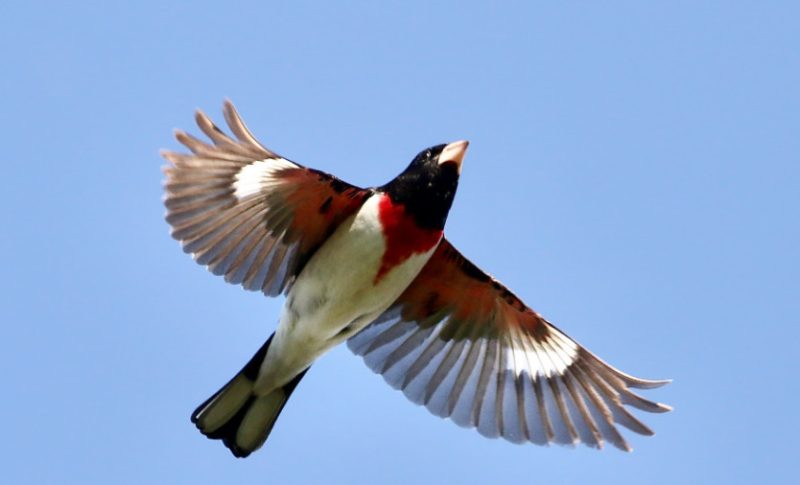
Renowned for its beautiful coloring, the Rose-breasted Grosbeak is a tricolored bird closely related to the Cardinal family. While females have a more subdued appearance with streaked brown and white feathers, males have vivid rose-colored breasts and black and white wings. They can also be identified by their black bellies.
These birds migrate, spending the summers in North America and the winters in Central and South America. Their melodic melodies reverberate throughout the forest, and they are frequently seen in woodland regions. However, because they prefer to remain in the trees, it might be difficult to find them.
The Purple Finch typically measures between 7 and 8.3 inches (18–21 cm) in length, weighs approximately 1.2 to 2.3 ounces (35–65 g), and boasts a wingspan ranging from 11 to 12.6 inches (28–32 cm). Its lifespan can extend up to 10 years.
White-winged Tern
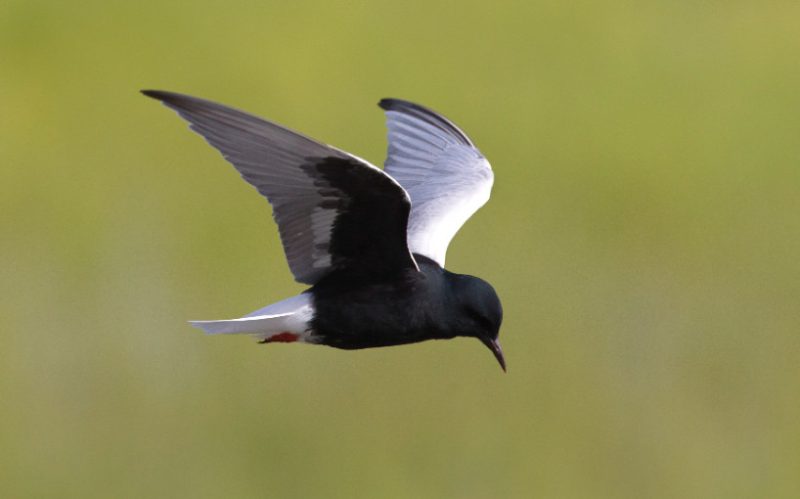
The White-winged Tern (Chlidonias leucopterus), identified by its dark plumage and striking white underparts, boasts a wingspan of 24–28 inches (60–70 cm). Renowned for its aerial prowess, it navigates effortlessly, exhibiting remarkable agility. These migratory birds breed in Europe and Asia before wintering in Africa and southern Asia.
During breeding, males sport all-black plumage with white wing stripes, while females flaunt brownish-gray feathers. With a lifespan of up to 10 years, they soar across continents, their elegance unmatched in the avian realm.
American Black Vulture
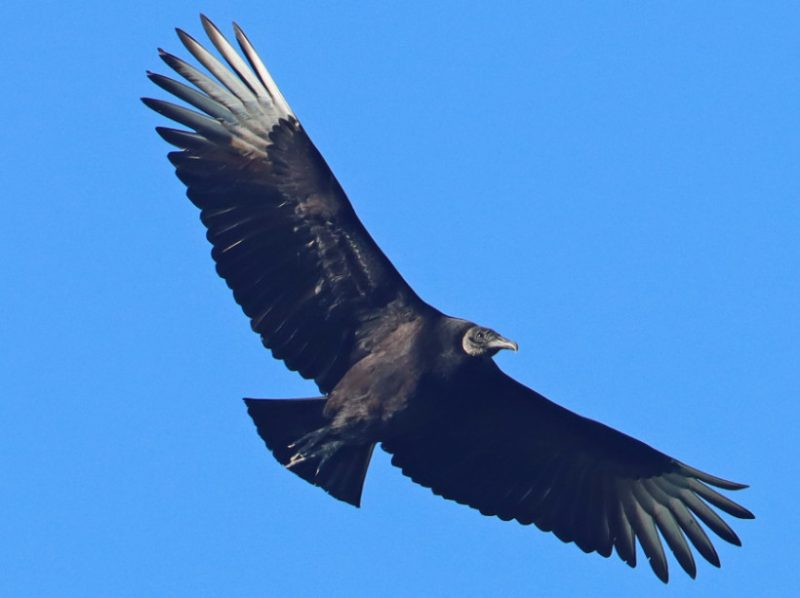
The American Black Vulture, or Coragieps atratus, is a mysterious and misunderstood bird that is frequently associated with rot and death. They are scavengers that feed on carrion and pierce tough hides with their strong beaks. Their acute vision allows them to detect food at great altitudes.
While on a birdwatching expedition, I saw these birds engaging in a practice known as “funeral circling,” in which they congregate around departed individuals. Although its exact function is still unknown, some people believe it to be a way to honor the deceased.
The American Black Vulture typically measures between 25 and 32 inches (63–81 cm) in length, weighs approximately 2.2–4.4 ounces (1000–2000 g), boasts a wingspan spanning 54–60 inches (137–152 cm), and can live for up to 20 years.
Lark Bunting
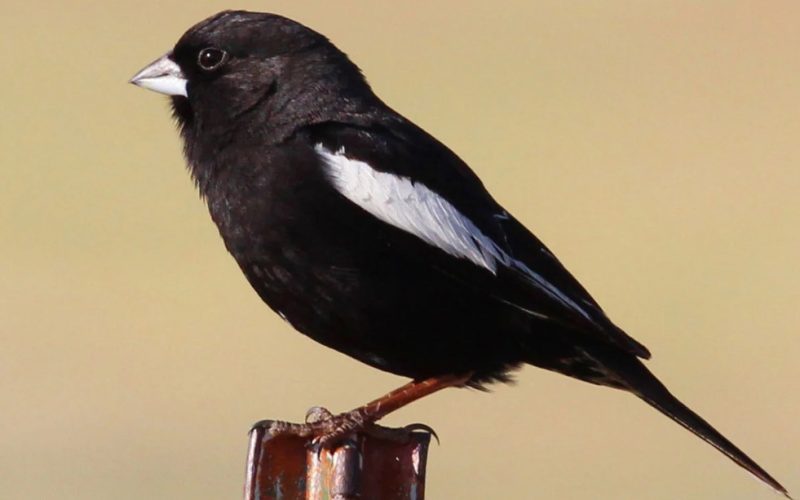
The gorgeous little Lark Bunting (Calamospiza melanocorys) is a native of the grasslands of North America. Their eye-catching black and white stripes make them stand out among the prairie grasses, attracting the attention of birdwatchers.
Males display jet-black plumage with white wing stripes and a pure white belly while breeding, while females have a more subdued brownish-grey color with black streaks. Known for their beautiful trills and whistles, these birds stake territory and court potential mates while serenading from atop grasses and shrubs.
The Lark Bunting typically measures between 5.5 and 7.1 inches (14–18 cm) in length, weighs around 1.3–1.5 ounces (38–42 g), and boasts a wingspan spanning 9.8–11 inches (25–28 cm). With a lifespan of up to 4 years, these small birds are well-adapted to thrive in the grasslands of North America.
White-winged Chough
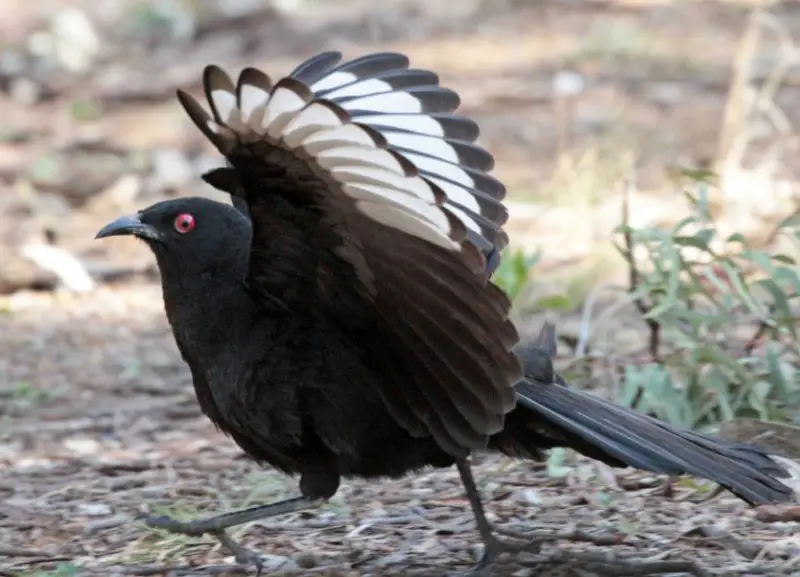
Originating in Australia’s forests and woods, the White-winged Chough (Corcorax melanorhamphos) is a gregarious and extremely intelligent bird. They frequently gather in large groups or families, and they use a variety of cries to communicate, including one that warns potential predators. They mostly eat insects and other small invertebrates that are found on the forest floor, with the occasional mammal or reptile rounding out their diet.
The cooperative breeding system of White-winged Choughs is a fascinating feature. Members of the group help breeding pairs with nest building, hatchling care, and predator protection.
The White-winged Chough typically measures between 18 and 20 inches (45–50 cm) in length, weighs approximately 8.8–12.3 ounces (250–350 g), and boasts a wingspan spanning 28–31 inches (70–80 cm). With a lifespan of up to 15 years.
Carnaby Black Cockatoo
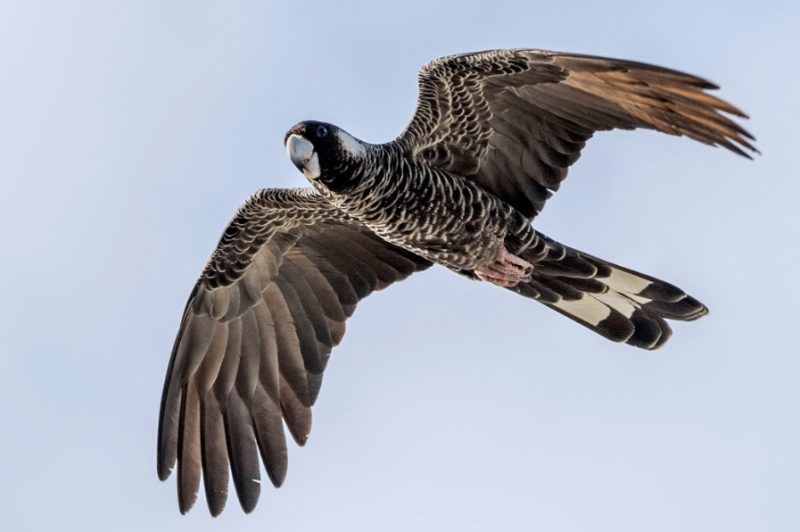
The Carnaby’s Black-cockatoo, or Short-billed Black-cockatoo, is a large black bird native to southwestern Australia. It’s identified by a distinct white cheek patch and wing stripes. Sadly, habitat loss has endangered them. Living in flocks, they communicate with various vocalizations, with males emitting deeper calls during breeding.
Found in woodlands, they feed on plant seeds like banksias and hakeas, nesting in large tree hollows, which exposes them to further habitat threats.
Carnaby’s Black-cockatoo typically measure between 21 to 23 inches in length and weigh from 14 to 56 ounces. With wingspans ranging from 31 to 43 inches, they possess remarkable lifespans of up to 50 years.
Yellow-headed Blackbird

Xanthocephalus xanthocephalus, the scientific name for the Yellow-headed Blackbird, is a species that is found in western North America. It has a bright yellow head and breast, with white patches on its wings, and is primarily black in color. Although they are not as colorful, females look like males.
Males sing a variety of melodies during the breeding season. For breeding, they favor wetlands and marshes, building their homes from the plants found there. They are omnivores that consume seeds, insects, and small animals. They frequently travel through marshy areas in groups to find food.
The Yellow-headed Blackbird, with a length ranging from 9.8 to 11 inches (25–28 cm) and a weight of 3.1 to 4.6 ounces (88–130 g), possesses a wingspan of 18 to 20 inches (46–51 cm). Its lifespan typically spans up to 10 years.
Crested Myna
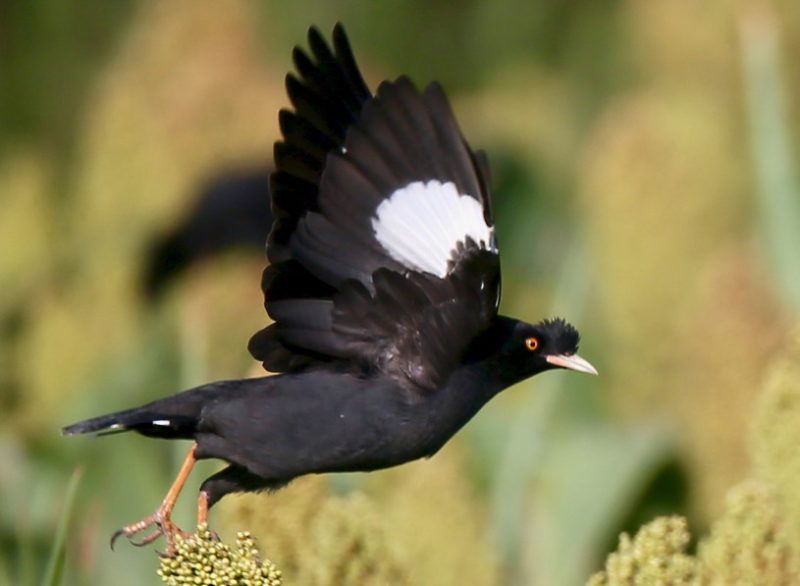
The Crested Myna, also known as the Chinese Starling, is distinguished by its glossy black plumage and distinctive white wing patches. Originating from southeastern China and Indochina, these birds showcase a lively and sociable demeanor. Often sighted in urban settings, they have a varied diet ranging from insects to human leftovers.
Renowned for their vocal repertoire, they emit calls such as “krrraa,” “kraak,” “cheep,” “chirrup,” “pweee,” and “pwit.” Their intelligence and adaptability are evident in their tool usage for foraging.
The Crested Myna typically measures 9–10 inches (23–25 cm) in length and weighs between 3.2 and 3.5 ounces (90–100 g). With a wingspan of 14–16 inches (36–41 cm), they can live up to 12 years.
Little Pied Cormorant
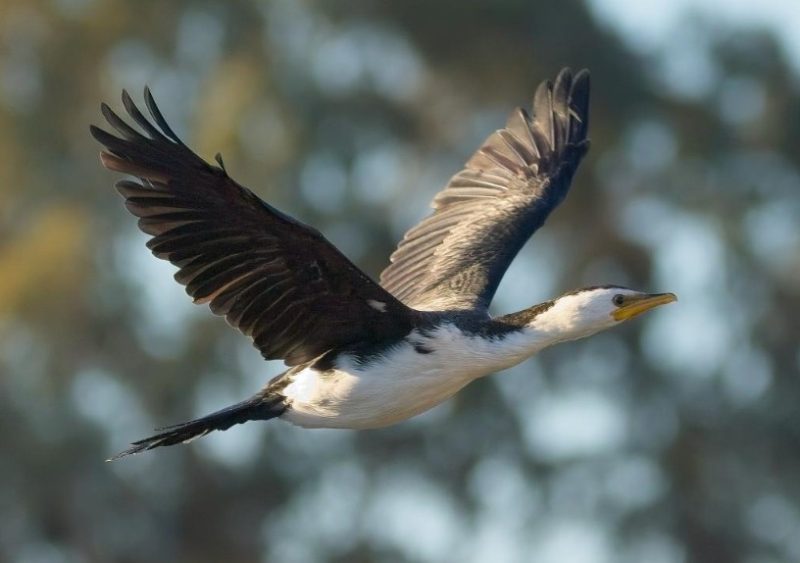
The dimensions of the Little Pied Cormorant are 22 to 23 inches (56 to 58 cm) in length and 15.9 to 22.9 ounces (450 to 650 g) in weight. Its wingspan is 30 to 34 inches (75 to 85 cm). The black bodies and white underparts, coupled with the white patches on each wing, set these little waterbirds apart.
They live in watery environments such as lakes, rivers, and marshes and are skilled hunters who use their strong legs and keen beaks to capture prey. The distinct sounds of Little Pied Cormorants, which include squawks, croaks, and grunts, can be used to identify them.
Ivory-billed Woodpecker
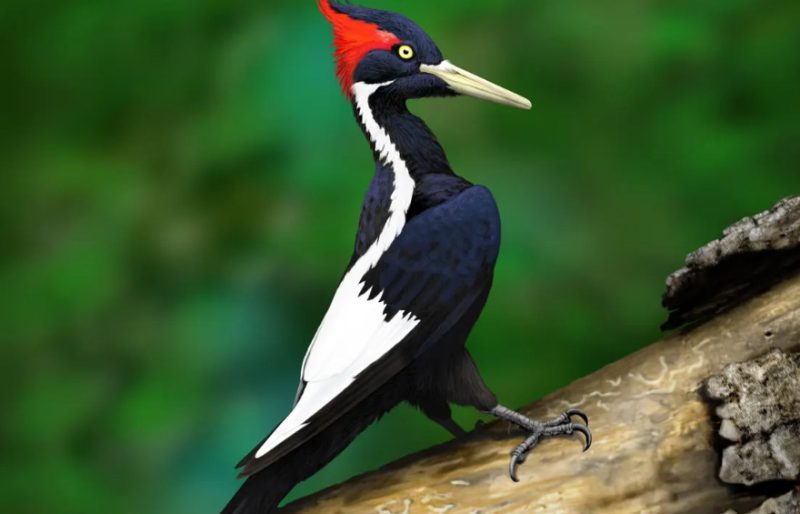
The Ivory-billed Woodpecker, or “Lord God Bird,” is a large, rare species once widespread in the southeastern United States. Recognizable by its striking black and white plumage, white wing stripes, and ivory-colored bill, it’s critically endangered.
It is about 17–20 ounces (480–570 g) in weight and measures 18–20 inches (46–51 cm) in length and 29–31.5 inches (74–80 cm) in wingspan. This woodpecker is still among North America’s most elusive birds, distinguished by its deep woodland habitat and unique sound.
Anhinga
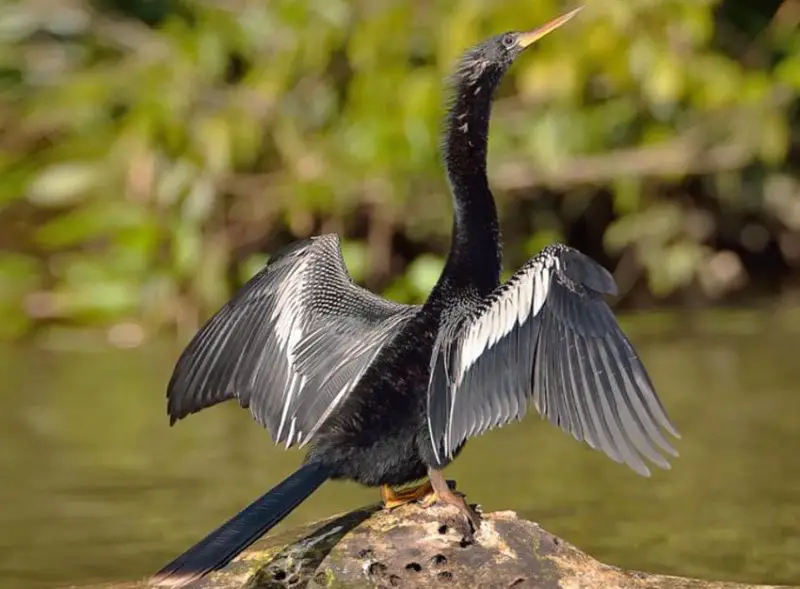
The Anhinga, also known as the “water turkey” or “snakebird,” measures between 32 and 37 inches (81–94 cm) in length, weighs approximately 40 to 70 ounces (1134–1984 g), and boasts a wingspan of 43 to 47 inches (109–119 cm).
With a lifespan of up to 10 years, this waterbird is well-adapted for its aquatic lifestyle, characterized by its long, slender neck, pointed bill, black body with white and silver wings, and distinctive crest on its head.
Emitting a guttural croak, they’re commonly found near water bodies in the southeastern United States, the Caribbean, and parts of South America. Known for their swimming and diving prowess, they hunt underwater, diving to depths of up to four feet.
Killdeer
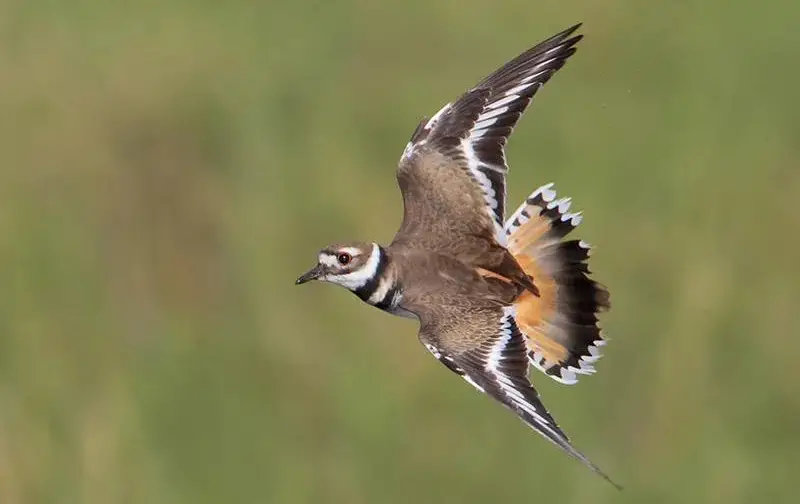
The Killdeer, scientifically known as Charadrius vociferus, measures between 7.9 and 11 inches (20–28 cm) in length, weighs around 2.5 to 4.3 ounces (72–121 g), and possesses a wingspan of 23 to 25 inches (59–63 cm).
Characterized by its slender body, long legs, and distinctive black and white wings, it’s a common sight in North American grasslands.
Known for its loud, shrill call, “kill-deer, kill-deer,” Killdeers are skilled hunters of insects and small animals, often found in open fields and agricultural areas.
Downy Woodpecker
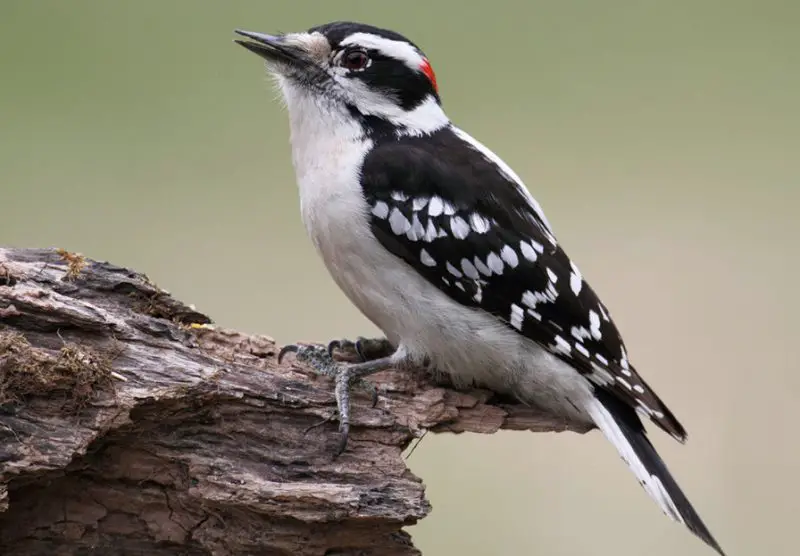
The Downy Woodpecker, scientifically named Dryobates pubescens, measures between 5.5 and 7.1 inches (14–18 cm) in length and weighs about 0.7 to 1 ounce (20–28 g), with a wingspan ranging from 9.8 to 11.8 inches (25–30 cm).
Found throughout North America, these lively birds boast black wings adorned with bold white stripes and a distinctive black-and-white checkered back pattern. Despite their small size, their unmistakable call and drumming make them easily recognizable to birdwatchers.
Known as cavity nesters, they excavate holes in trees for shelter and primarily feed on insects found under bark and wood.
Black Skimmer
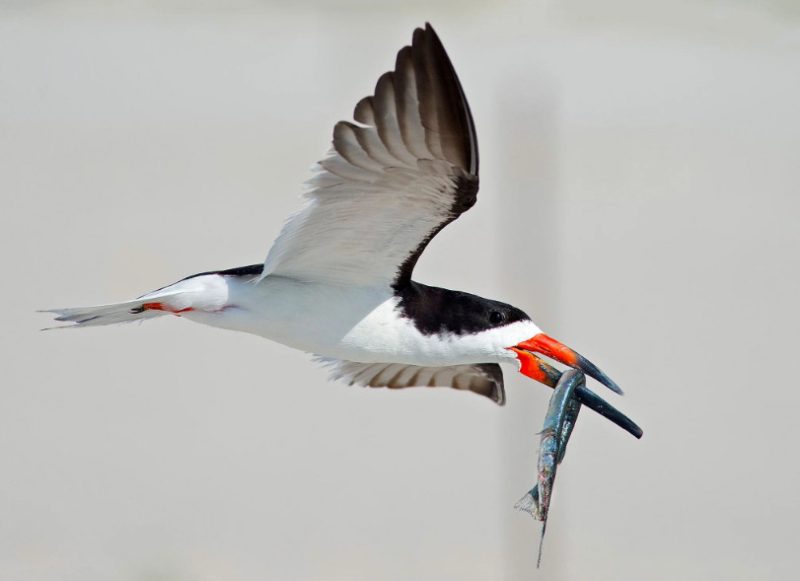
The Black Skimmer, scientifically known as Rynchops niger, measures between 16 and 20 inches (40–51 cm) in length and weighs approximately 8 to 14 ounces (230–400 g), with a wingspan spanning 42 to 50 inches (107–127 cm).
These seabirds, found along the coasts of North and South America, boast a predominantly black body with a striking white patch on their wings. Their most notable feature is their elongated lower mandible, which enables them to skim the water’s surface with precision, capturing fish effortlessly.
During the breeding season, they congregate in large colonies on sandy beaches or spits, where they lay their eggs in shallow depressions in the sand. Both parents take turns incubating the eggs and caring for the chicks. Additionally, Black Skimmers are recognized by their distinctive vocalizations, consisting of sharp barks and grunts.
Common Hoopoe
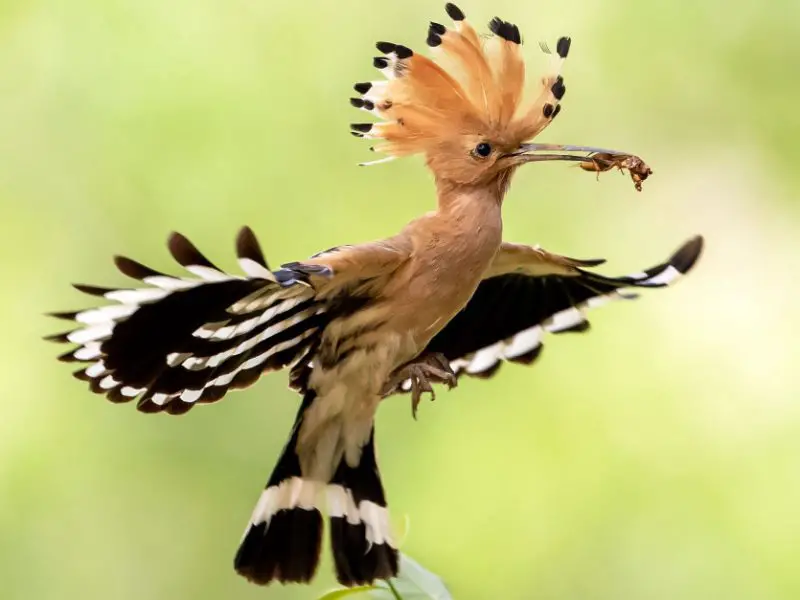
The Common Hoopoe, scientifically named Upupa epops, measures between 9 and 12 inches (25–32 cm) in length and weighs about 1.4 to 3.4 ounces (40–96 g), with a wingspan spanning 17 to 19 inches (44–49 cm).
This unique bird showcases plumage adorned with black, white, and cinnamon-brown hues. Notably, hoopoes are recognized for their peculiar behavior of repeatedly raising and lowering their crest, accompanied by a distinctive call resembling “hoop-hoop-hoop” or “oop-oop-oop.”
Found in various habitats, including woodlands, grasslands, and urban areas, they play vital roles as pollinators and insect controllers in ecosystems.
Bobolink
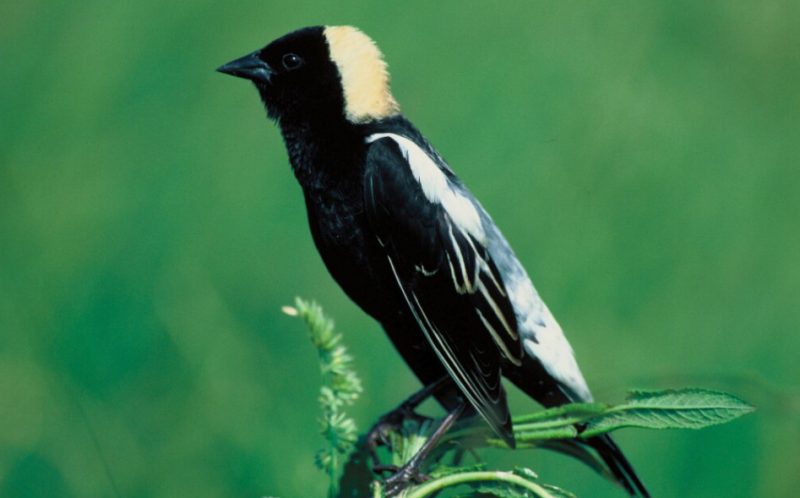
The Bobolink, scientifically known as Dolichonyx oryzivorus, is a medium-sized bird, measuring 6.3–7.5 inches (16–19 cm) in length and weighing 1.2–1.8 ounces (34–51 g), with a wingspan of 9.8–11.8 inches (25–30 cm). These migratory birds breed in North American grasslands and winter in South America.
Males have a striking black nape and head, white back, and buff-colored breast during breeding season. Unfortunately, habitat loss from intensive farming and development has led to their population decline.
Tricolored Blackbird
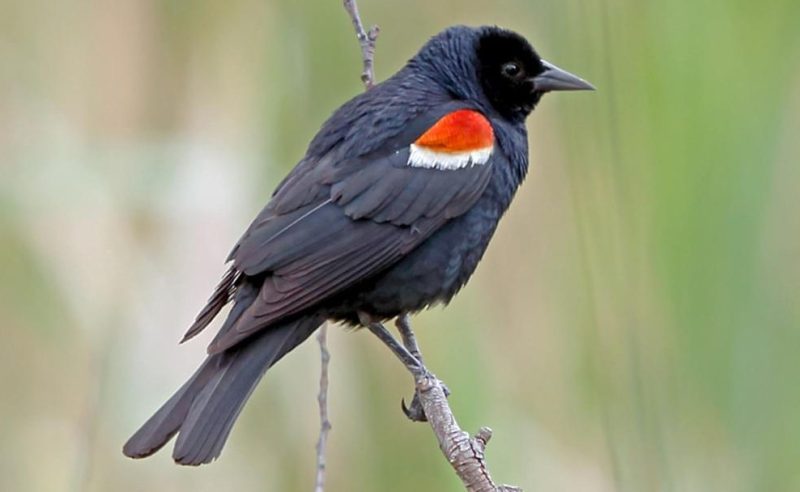
The Tricolored Blackbird, scientifically known as Agelaius tricolor, is a medium-sized songbird native to California’s Central Valley, exclusively inhabiting wetlands and open fields. Recognizable by their black plumage with a bright red shoulder patch and white wing stripe, males sport a yellow head and breast, while females have a dark gray appearance.
They nest in large colonies, displaying aerial acrobatics during the breeding season. Threatened by habitat loss, pesticides, and nest destruction, their conservation status is endangered.
The Tricolored Blackbird, with a length ranging from 7.1 to 9.4 inches (18 to 24 cm), weighs between 1.4 to 2.6 ounces (40 to 75 grams), boasting a wingspan of 10.2 to 13 inches (26 to 33 cm). They typically live up to 8 years.
Pied Oystercatcher
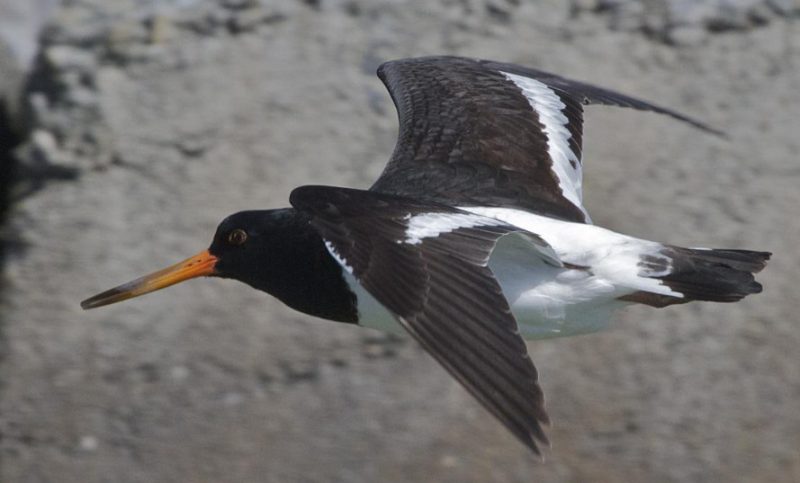
The length of the Pied Oystercatcher is 17 to 21 inches (43 to 53 cm), and its weight is 24 to 36 ounces (700 to 1050 g). Its wingspan is 35 to 43 inches (89 to 109 cm). With a large, vivid orange bill that they use expertly to crack open shells, these birds, whose lifespan can reach 25 years, have black and white plumage.
They are known for their territorial behavior and distinct “wheep wheep” vocalizations heard along the shorelines. Found along the coasts of Australia and New Zealand, they contribute to the coastal biodiversity of these regions.

